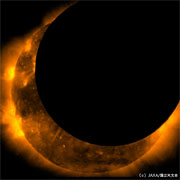Topics List
Aug. 22, 2017 Updated
Great American Eclipse on 21 August 2017: public release of images and videos taken by the "Hinode" satellite
|
The Japan Aerospace Exploration Agency (JAXA), the National Astronomical Observatory of Japan (NAOJ/NINS), and the US National Aeronautics and Space Administration (NASA), release partial eclipse images and videos taken on August 22 (JST) with the solar observation satellite "Hinode".
|
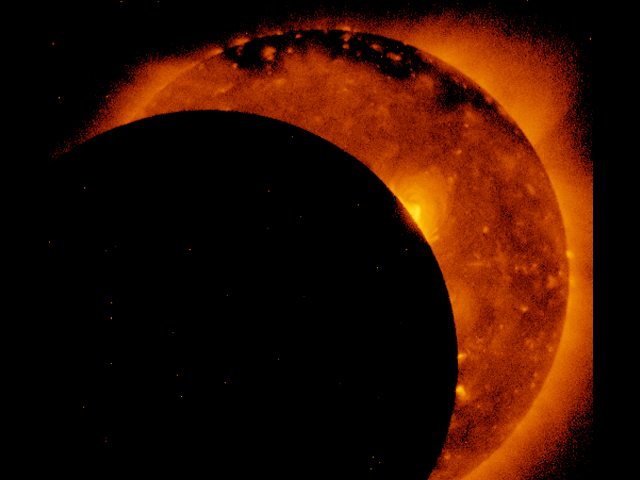
|
|---|
May 11, 2016 Updated
HINODE captured the transit of Mercury across the Sun
|
Mercury marched in front of the Sun from 11:11 UT to 18:44 UT on May 9. Hinode, which is on a Sun-synchronous orbit around the Earth, was able to observe this event without atmospheric distortion.
|
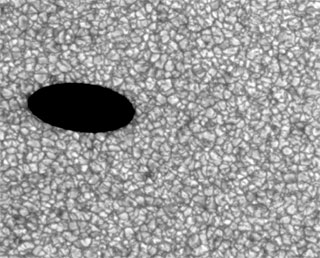
|
|---|
Mar. 10, 2016 Updated
HINODE captured partial solar eclipse
|
JAXA, NAOJ/NINS, and NASA, release partial eclipse images and videos taken on March 9 with the Solar Physics Satellite “Hinode”.
|
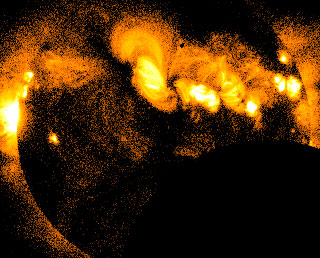
|
|---|
Oct. 27, 2014 Updated
HINODE encountered annular solar eclipse
|
On Oct. 24, 2014, the Solar Physics Satellite “HINODE” was in a straight
line with the Sun and the moon on orbit to observe the annular solar
eclipse. JAXA, the National Institutes of Natural Science, the National
Astronomical Observatory of Japan, and NASA took images of the scene and
published the X-ray solar photos and movies of the annular solar eclipse.
The HINODE flew into the shadow of the moon (in the antumbra observed
during the annular solar eclipse, the diameter of which is 187 km) while
flying over the North American continent at an altitude of 680 km at
around 6:53 a.m. on Oct. 24 (JST.) This annular solar eclipse was seen
only in orbit, and it was observed as a partial solar eclipse from the
North American continent (the U.S. and Canada) and other areas on the
23rd (universal time).
|
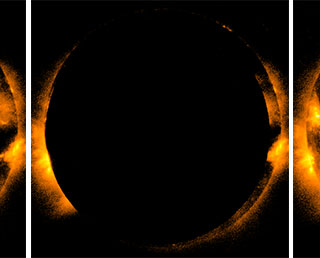
|
|---|
Nov. 19, 2012 Updated
HINODE captured total solar eclipse over Australia
|
The Solar Physics Satellite “HINODE” captured the scene of the total solar eclipse in Australia. Its onboard X-ray telescope (XRT) took images of the sun gradually being covered by the moon at around 5:25 a.m. on Nov. 14, 2012 (Japan Standard Time), while the HINODE was flying over northern Australia. The moon appeared from the south, then moved in front of the sun toward the north western direction. The images show that the black moon was traveling with a bright solar corona behind it. |
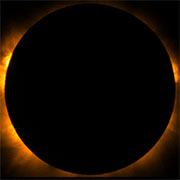
|
|---|
Jun. 6, 2012 Updated
HINODE captured the transit of Venus across the Sun
|
On June 6 (Wed.), HINODE captured images of Venus passing in front of the Sun, which was an astronomical spectacle observed from all over Japan. The acquired images show that the rim of Venus was brightened like a ring due to sunlight that underwent a refraction bend through Venus' atmosphere, when Venus was about to come in front of the Sun from its north-eastern side. |
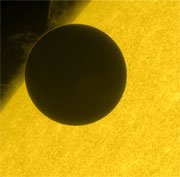 |
|---|
May 21, 2012 Updated
HINODE shot partial solar eclipse
|
On May 21, 2012, the Solar Physics Satellite “HINODE” took photos of a partial solar eclipse. X-ray solar images and movies released today were shot when the HINODE flew over the East China Sea toward Indonesia at around 6:34 a.m. on May 21 (Mon., Japan Standard Time.) The X-ray telescope (XRT) aboard the HINODE captured a scene where the moon appeared from the south west side of the sun and traveled across in front of the sun to the north west, thus the black moon passed in front of the solar corona. |
Apr. 20, 2012 Updated
Hinode observations revealed polar field reversal only at North Pole of the Sun!
|
An international research team mainly consisting of researchers from the National Astronomical Observatory of Japan and RIKEN has observed the north and south polar regions of the Sun using JAXA’s Solar Physics Satellite "HINODE." As a result, they found that between 2008 and 2012, the reversal from minus to plus polarity of the magnetic field was taking place only in the north polar region, while the magnetic field did not change much in the south polar region. |
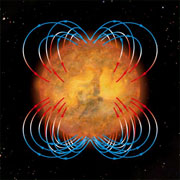 |
|---|
Mar. 8, 2012 Updated
HINODE captured precursor of sunspot penumbra formation for first time
|
The solar physics satellite "HINODE" successfully carries out continuous observations of the formation process of a large sunspot from its birth. |
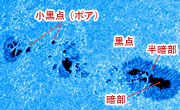 |
|---|
Aug. 31, 2011 Updated
HINODE: Observation results of magnetic field
|
JAXA reported the observation achievements by the solar physics satellite "HINODE" to the Space Activities Commission. |
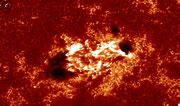 |
|---|
Mar. 17, 2011 Updated
HINODE observes huge flare
|
The Solar Physics Satellite "HINODE" observed a huge flare (explosion phenomenon) on the surface of the sun at 10:44 a.m. on February 15, 2011 (Japan Standard Time.) The HINODE is set to automatically convert its observation mode to "flare observation mode" whenever a solar flare occurs. The onboard "Solar Optical Telescope" and the "X-ray telescope"carried out the observation. |
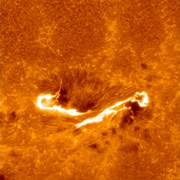 |
|---|
Jan. 7, 2011 Updated
Annular solar eclipse observed by HINODE
|
The Solar Physics Satellite “HINODE” observed an annular solar eclipse on January 4, 2011. The eclipse this time was a partial one from the Earth, but from the HINODE, which flies at an altitude of 680 km above the Earth, it was seen as an annular solar eclipse. (Images observed by HINODE's X-ray telescope (C) NAOJ/JAXA) |
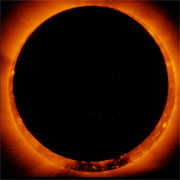 |
|---|
May 19, 2010 Updated
"Hinode" discovers the origin of white-light flare emission
|
A Japan-US international research team led by Dr. Kyoko Watanabe, a JAXA aerospace project research associate, has identified the origin of the white-light emission in solar flares, by quantitatively analyzing an X-class solar flare. This flare was successfully observed by two solar observing satellites: JAXA launched "Hinode" and NASA's RHESSI. The origin of the white light emission has not yet been clarified since its first discovery about 150 years ago. This finding is published in the May 20, 2010 issue of the Astrophysical Journal. |
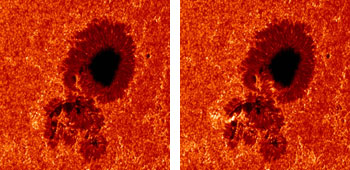 |
|---|
Mar. 9, 2010 Updated
HINODE finds strong magnetic fields in Sun's polar region
|
An international research team including scientists from the National Astronomical Observatory carried out observations of the magnetic landscape of the Sun's polar region, which have been difficult to observe, using the onboard Solar Optical Telescope of the solar Physics Satellite "HINODE." As a result of the observations, the team found that extremely strong magnetic fields of over 1,000 Gauss, which is about the same level as a sunspot, scatter in the Sun's polar region. This achievement was attained because the HINODE successfully acquired clear images of the Sun's polar region for the first time in the world. |
 |
|---|
Nov. 5, 2009 Updated
HINODE clarifies the origin of low-speed solar winds
|
The origin of low-speed solar winds was found to be at the parting plane of the magnetic field that exists at the end of the active area of the winds. This finding was achieved by combining the observations of the Solar Physics Satellite "HINODE" and those of photosphere magnetic fields. |
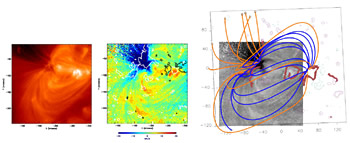 |
|---|
Jul. 22, 2009 Updated
Images of total solar eclipse taken by HINODE
|
A total solar eclipse was observed from Japan on July 22 for the first time in 46 years, and the Solar Physics Satellite "HINODE" observed the moon crossing in front of the sun. |
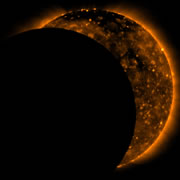 |
|---|
Apr. 8, 2009 Updated
A new solar dynamo mechanism discovered by the Hinode satellite
|
The Sun has strong magnetic fields as represented by sunspots. The mechanism to create such strong magnetic fields is still a mystery, and is one of the most important problems in astronomy. Such magnetic fields on the surface of the Sun are known to drive dynamic activity such as solar flare, and eruptions which in turn can lead to geomagnetic disturbances that can have influence on the Earth and thereby on humans. Studies of the Sun, in particular, of its magnetic fields, are critically important in this respect too. |
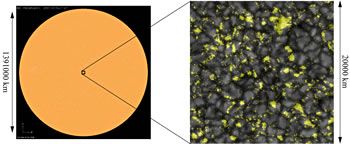 |
|---|
Oct. 7, 2008 Updated
HINODE observed the dynamism of a polar crown prominence
|
HINODE's onboard Solar Optical Telescope (SOT) acquired high-resolution moving images of an atmospheric structure called a "polar crown prominence," which is observed frequently near the poles of the Sun. The SOT successfully captured the dynamic movement of the polar crown prominence with high resolution for the first time in the world. |
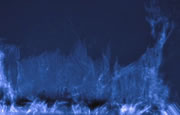 |
|---|
Apr. 8, 2008 Updated
Wind velocity at the outset of low-speed solar wind identified by HINODE
|
HINODE's onboard X-ray telescope (XRT) observed that high-temperature gas emanated out constantly from the edge of the activity region adjacent to a hole in the sky above the corona. We further examine the phenomenon using the HINODE's onboard Extreme-ultraviolet Imaging Spectrometer (EIS,) and the velocity of the high-temperature gas emanation was about 100 km/second. This figure is consistent with the projected value based on the XRT observation. |
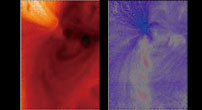 |
|---|
Dec. 7, 2007 Updated
Hinode Featured in Science
|
Hinode (SOLAR-B) has brought us a new perspective of solar physics since its launch on September 22, 2006. Sience magazine, one of the leading journals of scientific research, features Hinode discoveries. An impressive picture obtained with Hinode appears in the front page of the journal. This press release highlights two of nine articles published in the special issue. [image: (C) NAOJ/JAXA/NASA/STFC/ESA] |
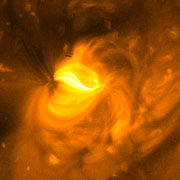 |
|---|
May 31, 2007 Updated
Observation data from HINODE (SOLAR-B) released to the public!
|
The Solar Observation Satellite HINODE (SOLAR-B) has been regularly carrying out observations using all its observation instruments. Previously, we have released only a limited portion of images from the HINODE on our web site, but on May 27, 2007, we disclosed all the observation data to the world. To commemorate this achievement, we have also released videos of long term x-ray observations and the latest images from the X-Ray Telescope (XRT) on our web site. |
 |
|---|
Nov. 9, 2006 Updated
Mercury Transit across the Sun as Observed with "Hinode"
|
The Mercury transit event across the Sun that took place in the morning of 9 November 2006 JST was successfully observed in great detail with the three telescope instruments aboard HINODE satellite. Panels below show images from HINODE for the episode around the contact of Marcury to the solar disk (i.e., around first and second contacts). |
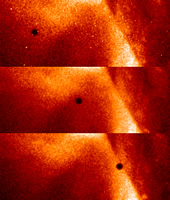 |
|---|
Sep. 25, 2006 Updated
M-V-7 successfully launched Nickname is "Hinode"
|
The Japan Aerospace Exploration Agency (JAXA) launched the M-V Launch Vehicle No. 7 (M-V-7) at 6:36 a.m. on September 23, 2006 (Japan Standard Time, JST) from the Uchinoura Space Center (USC). |
 |
|---|
